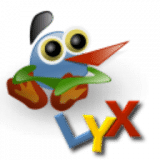Free
Absolutely Free
LyX overview
LyX is a fully fuctional WYSIWYM (what you see is what you mean) frontend for LaTeX wnich allows users with no programming knowledge to get the full benefits of LaTeX. It differs from products such as TeTeX as one needs to know no code and can simply write and mark any text as a footnote of chapter heading etc., and then hit the PDF button to get a perfectly formatted output.
What’s new in version 2.3.7
Updated on Mar 01 2023
- Release notes were unavailable when this listing was updated.
Information
App requirements
- Intel 64
- Apple Silicon
- Mac OS X 10.6 or later
Try our new feature and write a detailed review about LyX. All reviews will be posted soon.
(0 Reviews of )
There are no reviews yet
Comments
User Ratings
Jun 13 2019
Version: 2.3.2
With LyX available I don't know why anyone would want to use any LaTeX coding app.
Sep 29 2014
Version: 2.1.2
I wrote my entire PhD thesis with this wonderful software and Jabref years ago. The tracking function is good enough for collaboration between my advisor and me.
Good job!
Apr 25 2014
Version: 2.1.0
This is a very nice document preparation tool. My main usage case was to typeset notes with lots of math and also prototype journal articles. The disadvantages is that not everyone uses it so if you collaborate with anyone who doesn't use it (usually your boss) you have to switch to latex and also sometimes in order to publish you need to make micro-adjustments, which are usually one command in latex but require a lot of drilling in lyx. But this is understandable as there can be no perfect GUI. For the mac there is also the problem is that it is not retina ready and this does not seem to be a priority for the developers (also understandable since it requires an update of the toolkit and all the bindings and probably that is too complicated). It is still perfectly usable of course, but add this all up and a modern latex editor with live preview seems to be more practical these days. And I say this after using lyx for 10 years. I still recommend it as an educational tool for latex or for the people who are not very demanding with their documents (i.e. they don't need to publish). For whoever wants to use latex for publishing (or for collaboration), there is no way to escape learning it in the end and using lyx will simply delay the inevitable.
Jul 2 2012
Version: 2.0.4
I cannot convey how awesome this is. I don't have the time to learn TeX, but this has given me all the benefits. I am very proficient with Word, but this is a completely different way to approach word processing / text layout, and much better if you ask me. The learning curve is a touch steep if you are not prepared to read the manuals, but I have become completely comfortable in a matter of days without once checking a manual. I use this with Bibdesk and Preview and am amazed at how organised you academic life can be.
Sep 15 2011
Version: 2.0.1
I'm just getting up to speed with LyX after turning up my nose at it a few times over a few years. This time, I am mightily impressed. This is hands down the easiest way to make structured documents and have them typset with the uber-capable LaTeX system. You don't have to learn to code LaTeX but if you know it already, you can always embed it to your heart's content. The first thing you have to get use to is, this isn't Microsoft Word. And that's a good thing. The ability to completely change the look of your document with a couple of mouse clicks is amazing. This is useful for all sorts of reasons, not the least of which is submitting work to different places which require different layouts. The developers have worked hard to make this non-Linyxy, porting it to the Qt framework to give it a fairly Mac-like appearance. (I'm a stickler for Mac-like behavior, and the Qt framework has some annoying behaviors but it's a huge, huge improvement over the X system.) The on-screen appearance is surprisingly WYSIWYG, which is helpful in long writing sessions. But, as the developers like to say, this is What You Get Is What You Mean, or something like that. The payoff comes when you hit Command-R and in a few seconds your default PDF viewer opens with a beautifully-rendered professional-looking page. You can't imagine how much better a true typeset page looks when compared to the usual output from a word processor. And to see it set in the format of your favorite journal is pretty cool. Yes, there is a learning curve, but so is there a learning curve with any program that does non-trivial word processing. The documentation for LyX is unusually good (for an open source project), and the developers are quite responsive.
Jun 9 2009
Version: 1.6.3
Whilst I'm told this is excellent for writing, it's causing me nothing but trouble. I author scientific papers and I've learnt to use LaTeX normally. Anytime someone can't use LaTeX and can use only LyX it makes collaboration total hell.
If you write documents on your own, fair enough, but if you write documents with other people who don't use LyX then raw LaTeX obviously supersedes it! Ultimately it's better to learn LaTeX. It really isn't that difficult.
Mar 16 2008
Version: 1.5.4
LyX (LaTeX) proofs to be a very nice text processor for educational scientists. They do a lot of statistical and qualitative data analysis, wright complex and long documents like theses and books. Compared to programms aiming for office use, LyX is reliable and easy to use. I.e. the integration of BibTex is nicer then EndNote@Word.
There are a hand full pitfalls you have to know how to avoid. If LaTeX refuses the text setting into pdf, there are a few possible reasons for this. Best hints:
- the error messages will highlight the problematic zone(s)
- Use the the "go back" arrows in LyX, until your document is in a workable state.
Mar 21 2006
Version: 1.4
In many ways better than LyX 1.3x; however, mine crashes every time I quit. This is not really bad, but it's not good either. However, I suggest that everyone who uses LateX or avoids using LaTeX give this a try. I have completely converted from LaTeX to LyX
Mar 4 2006
Version: 1.3.7
Best peace of software ever!
Congratulations to the team...
E;-°)))
Jan 18 2006
Version: 1.3.7
Thanks to the Mac developers of this - if it weren't for their hard and excellent work, I'd still be using LyX in X11. Thank goodness!
Sep 21 2005
Version: 1.3.6
I followed every instruction, couldn't get it to fully work under Tiger. Kept giving me errors about missing classes, despite my LaTeX installation being in the standard Fink location. This thing needs some more work. You shouldn't have to run a shell script during a Mac install, anyway.
Jul 21 2005
Version: 1.3.6
1.3.6 works great here.
LyX, despite the previous reviewers' aversions to non-'mac-like' programs (because hand-coding is SO mac-like), is easy to use, and produces gorgeous documents.
LaTeX for the rest of us.
I've been using LyX for papers, letters, and most writing tasks for the past two years without problem.
Great work!
Jul 20 2005
Version: 1.3.6
Plain doesn't work - "Missing TeX class". Tried reconfiguring, tried recreating a .lyx directory, reconfigured again. Nothing. This is supposed to be a bug *fix* release.
Dec 9 2003
Version: 1.3.3
Ronald Florence posted this to the LyX mailing list, thought it should go here as well:
1. No blanks in paths: this is a LaTeX issue, not a LyX/Mac issue.
2. The reLyX option in the file->import menu is listed as "Latex" and
works fine.
3. The pull-down menues do sometimes misbehave (this is a Qt/Mac
library problem).
4. Yes, as the HOWTO makes clear, teTeX is a prerequisite for a
working LyX/Mac.
Nov 24 2003
Version: 1.3.3
This is a great program for people who use LaTex for things like articles, but want a simple, yet powerful solution (not MS Word) for shorter tech documents. Lacks the customizability of LaTex, but also all the hastle. I am an academic. I use LaTeX for articles, and I use Lyx for homework assignments and exams.
There are still some file problems. Don't put a ' ' anywhere in your file path. This is a very UNIXy program. People with UNIX/LaTex experience won't mind this. Others might
Nov 24 2003
Version: 1.3.3
A nice Mac port of the overwhelming LyX-app. Works fine despite of some minor problems (for instance the pull down menues in the open dialog window sometimes open up in the upper left corner).
Most serious bug as far as I can see is that in 1.3.3 the highly important reLyX option in the file->import menu does not exist. I hope a fix will be available soon.
Free
Absolutely Free
Similar apps
TeXMaker
A developer-focused LaTeX toolkit.
Is this app is similar to TeXMaker? Vote to improve the quality of this list.
Vote results
0
Upvotes
2
Total score
0
Downvotes
TeXShop
TeX front-end.
Is this app is similar to TeXShop? Vote to improve the quality of this list.
Vote results
1
Upvotes
1
Total score
0
Downvotes
TextMate
Code/markup editor with many features.
Is this app is similar to TextMate? Vote to improve the quality of this list.
Vote results
0
Upvotes
1
Total score
0
Downvotes
TeXnicle
LaTeX editor and project organizer.
Is this app is similar to TeXnicle? Vote to improve the quality of this list.
Vote results
0
Upvotes
1
Total score
0
Downvotes
TeXstudio
Fully-featured LaTeX editor.
Is this app is similar to TeXstudio? Vote to improve the quality of this list.
Vote results
0
Upvotes
1
Total score
0
Downvotes
New and Recently Updated


























